- Home
- Gary Vaynerchuk
The Thank You Economy Page 6
The Thank You Economy Read online
Page 6
3. Social media is still too young.
The wait-and-see approach, the one most companies have used while considering when to invest in traditional platforms, won’t work for social media. First-to-market in this hyper-fast world has impact. Companies can no longer just spend money and get in on the game. Before, it wouldn’t have mattered if, hypothetically, Nike (which wasn’t founded until the mid-1970s) had taken one look at the radio when it was first invented and said, “Cripes, this is going to be big, it’s going to be in cars!” and gotten a $3 million head start over Adidas. Six years later, once Adidas had looked around and said, “Darn, Nike was right!” and pounded the platform with a $4 million campaign, it would have been even with, if not ahead of, Nike. All Adidas would have had to do was spend a lot of money to push its message out and the consumer would have swallowed it, because there was so much of it they could hardly see anything else. It could have trumped the other company’s longer presence on the platform with volume, a push platform. Companies can’t buy volume in social media, though, so today, those six years Nike would have had on Adidas would count a great deal, because those are six years that Nike would have been going into the trenches, talking to people and inviting them to talk back, creating an emotional bond and solidifying its relationship with the consumer. Adidas wouldn’t be able to come out of nowhere and magically create relationships where there aren’t any, and it would have a hard time pulling customers away from Nike because they would be emotionally attached.
Adidas would not be locked out, though. If its leaders channeled their efforts in the right direction and created a campaign that really communicated with people and made consumers feel as though Adidas cared more about them and their business than Nike did, they could still close that emotional gap. It could take a little while, but it would definitely be doable.
For once, I’m begging businesses to take the easier path. Embarking on one-to-one customer engagement offers significant long-term rewards, but the company will also experience immediate benefits—greater brand awareness, stronger brand loyalty, increased word of mouth, improved understanding of customer needs, and better, faster consumer feedback—and suffer very few drawbacks, if any. Meanwhile, the drawback to resisting social media engagement is clear: the longer you wait, the farther the competition can pull ahead.
Jumping on social media platforms early gives you a tremendous advantage, because people are more engaged early on as they explore all the possibilities of the medium; there’s more chatter, more overall usage, and less noise to break through. You don’t have to shout and turn cartwheels to be heard. Being first on the scene is not all that counts, and you can certainly catch up later, but your cost of entry will be significantly higher, and you will work considerably harder.
The kind of impression you’re trying to make can’t be bought the way it could on the traditional media platforms. This isn’t just about hitting someone with an image so many times it sears your brand name into the person’s brain. It’s about building relationships, and relationships take time. The twelve months you wait to get in on this is twelve months that your competitor will have spent connecting and building goodwill and trust with customers who could have been your customers. On this platform, it’s not just the thirty or sixty seconds of a well-placed spot that have value—all time has value, just as it does in the real world.
During my first three and a half years of high school, I was so consumed by my baseball card business and my job at Wine Library, which was then called Shopper’s Discount Liquors, I hardly ever socialized with my classmates. Then, around spring break of senior year, I realized that I was about to miss out, and that I had one last chance to make up for it. So I threw myself into the social scene. I have an outgoing personality and a good sense of humor, and I became more popular pretty quickly. But do I have the same connection to high school friends as classmates who invested all four years into building relationships with each other? Absolutely not. Real, lasting friendships take emotional investment, and I took too long to decide to invest. Social media relationships and personal relationships work exactly the same way—you get out of them what you put into them. You can’t buy them, force them, or make them into something they’re not ready to be.
The longer you hesitate to build a presence on this platform, the more you will struggle to make it work for you. That’s why so many brands, especially celebrity brands, are having a hard time with it. Many big names are not jumping onto Twitter and Facebook because they fear that if they do it now, they could hurt their brand more than help it. What if they launch and their numbers aren’t impressive? What if they don’t attract the huge flock of followers or fans they think they have?* Though as I keep repeating, the number of people with whom you have connections is far less important than the quality of those connections, it’s just a fact that most of the world looks at those numbers and judges you for them. Low numbers could hurt a brand. If this platform worked like TV or radio, a celebrity or an established brand might just buy someone else’s fan base to make themselves look better, much the way companies buy up smaller companies or databases. But that’s just it; this platform doesn’t work at all like yesterday’s platforms. Even if you could take over someone else’s fan base to boost your numbers, those numbers exist only because of the relationship that’s been built, a relationship entirely dependent upon a sustained authentic interaction between brand and customer. Rihanna can’t buy Kanye West’s fans; Blue Bell can’t buy Ben and Jerry’s fans. Amazon can buy Zappos, but it can’t buy Zappos’ fans. Amazon could do what many acquirers do—fold the newly acquired company into the parent company, adapt the Zappos business processes to match their own, take over the Zappos warehouses, suck all the soul out of it and leave nothing intact but the logo. Amazon would have the customers, sure, but it would not have the customer relationships. If Zappos were no longer the Zappos they knew and loved, the customers would abandon ship, and ultimately Amazon would gain nothing from the acquisition. Fortunately, Amazon gets that the key to Zappos’ success is to leave it alone and keep its soul intact, so it will probably reap the benefits it was looking to buy.
You can catch the leader in your space only if you get in the pool. So what if some people notice your numbers are a little low? I believe we’re dawning on an era when more people will recognize the value of quality over quantity, but until then, the effect of low numbers on your brand will feel like a bee sting compared to the hemorrhaging gunshot wound it will feel like if you do nothing. Get in, and then start swimming better and faster than anyone else. You do this by being more genuine and more caring, by creating better content, by keeping your thumb on the pulse of the space, and by being more engaged. By being better. You have to act like the guy who falls for the girl who just got dumped by the love of her life. How the heck are you going to get her to let him go, and make her see that you’re worth ten of that dude? With an unbelievable amount of patience, persistence, and understanding. Do it right, with genuine feeling, and there’s a chance that one day she’ll look at you the same way she used to look at him.
People want to have close relationships with their brands. It still sounds a little weird today, but one day it won’t. The right time to start building those relationships is right now.
4. Social media is just another trend that will pass.
One reason why business and marketing leaders may be slow to accept social media is that for all the talk about how fast the business world is always changing and how speed is of the essence, platforms have historically remained remarkably steady. Newspapers and magazines have been luring us with attention-grabbing headlines and alluring pictures for hundreds of years. It wasn’t until 1922 that radio gave companies a new platform with which to experiment, and then businesses had to wait more than two decades before TV gave them another opportunity in the late 1940s and ’50s. After that, forty years went by before the Internet arrived.
Given how spoiled they’ve been by the predictab
ility and stability of the one-way platforms they’re used to, it’s no surprise that most business and marketing leaders have been skeptical about the viability of social media as the next big one. But there’s a saying in the NFL: speed kills. Ten years ago, a five-foot-eight, 180-pound player would never have been drafted. Now, a really short, shifty, fast running back like Noel Devine can go into the first round. That’s how much the league has changed in a decade, and it has totally changed the game. Social media has changed the game in even less time, making levels of communication that would have been unthinkable ten years ago the norm today. The growth and technological shifts we are experiencing today have a faster and greater impact on business than they used to. You can’t expect any product’s penetration to follow the same pattern that, say, the Walkman did thirty years ago.
Some marketing planners don’t dismiss the idea of social media so much as they mistrust the sticking power of any particular platform. After all, in 2006 MySpace was hot, and within three years Facebook had overtaken it in terms of users and engagement. Why wouldn’t Facebook suffer the same fate when the next hot platform comes along? Well, if it’s not as good as the new thing, it will suffer the same fate as MySpace (though it should be noted that MySpace is not anywhere near dead yet, attracting 65 million unique users in September 2010, according to the market research company comScore). But it wouldn’t matter. If users one day abandon Facebook in favor of something better, they won’t be jumping off the train, they’ll simply be moving to a new car. Move with them. The relationships you’ve worked to build won’t evaporate so long as you follow your customers and keep up the caring. There have been plenty of lifelong friendships that started when someone from New York met someone from Florida while vacationing in Las Vegas. Before social media, they exchanged phone calls, and sent letters and holiday cards. Now they friend each other up. What happened in Vegas never has to stay in Vegas unless you choose to let the relationships you begin there die.
5. We need to control our message.
I would love to see that companies have recognized the stupidity of this argument by the time this book is in print, but I have a funny feeling many still won’t. A lot of companies resist building a Facebook wall, blogging, or starting a Twitter or YouTube account because an irate customer might post negative comments. So what? Would you prefer that the customer post them somewhere else where you have absolutely no way to reply? Or somewhere you can’t even find? If you’re that afraid of your customer, you might want to take a closer look at how you’re doing business.
You can’t control the message; that ship has sailed. Yes, things can go crazy-mad online, and companies have suffered from out-of-control negative word of mouth. But it’s highly unlikely that when companies sink under the weight of a mistake, it was entirely because of that mistake. If they folded, it was because there was something fundamentally wrong with the business model or with management that resulted in too many repeated problems. The one that brought the company to its knees wasn’t the only straw, just the final one that broke its back.
Small or midsize companies might fear that they wouldn’t survive a big faux pas the way a juggernaut might—like Tylenol, which suffered a blow almost thirty years ago when someone put cyanide in its pills and placed contaminated bottles back in stores—but they needn’t worry.
Overall, problems can be fixed if you catch them in time. If you plead your case quickly and sincerely, you’ll gain back the customers’ trust, as Ann Taylor did. When Ann Taylor LOFT introduced their silk cargo pants on their Facebook page in the summer of 2010, a wave of online customers complained that no one except a giraffe-sized, skinny model could possibly look good in them. To prove them wrong, LOFT employees of all heights and sizes posted photos of themselves wearing the pants. The response was extraordinary: tons of comments from women thanking LOFT for listening, some even admitting that they might wear the pants. This customer couldn’t be swayed, but her comment illustrates why it is in a brand’s best interest to nurture customer relationships:
I love LOFT and I sooooo appreciate you taking the time to “listen” to our comments and show these pants on “real” women. I hope you will continue to do this in the future. However, I still maintain these pants are UGLY. They dont even look like capris on #2. I did want to say thank you though and to let you know I shop at Loft, but these pants are FAIL. ;)
The customer still hates the pants, but now LOFT knows they’ve still got their evangelist out there, and there’s a good chance that she’s spreading the word.
When I first started working for my dad, any time a customer called or came to the store to complain, it would ruin his life. The man would go red in the face, he would get upset, he’d just want to go home. He was just crushed, which is a great testament to how much my father cared about his customers (and I respect and love him so much for being that way). I, on the other hand, was ecstatic when one of these unhappy customers called, because now that I knew there was a problem, I could try to fix it. I would spend the rest of my life fixing things for that customer if I had to. And it always worked, even when dealing with some of the toughest SOBs I have ever met. More than once I had to go to someone’s home and orchestrate a dinner and pour the wine—all for free. In this case, the cost of what I put into getting that customer back was rarely close to the yearly, maybe even lifetime, value of the customer (which is, by the way, the huge advantage that companies that aren’t trying to hit quarterly numbers have over publicly held companies). But I was creating a culture, and I was establishing my brand. I wanted my employees to absorb my vibe and mission, and layer it over everything they did. It’s possible that I lost eight hundred bucks bringing a particularly difficult customer back into the fold. But every time I did something like that, I won, because I was strengthening the DNA of my employees and my company, which paid off in the long run.
I would never put myself out of business, so I lost only what I knew I could afford to lose. Anyone can scale that kind of service and attention. What’s great is that now it’s far cheaper to cater to your customers this way than it used to be. Back then I had to go to someone’s house and pair wines with food for dinner, which kept my efforts local. Now I can make a personalized video on YouTube for free and send it to anyone, anywhere, with a bottle of wine or a $100 credit. There are so many more channels we can now use to communicate our good intent directly to our customers, with a personal, individually customized message that is impossible to achieve through TV or print.
You can fix anything unless you’re doing something grossly wrong. If you’re putting rat poison in your pickles or using child labor, no matter how cheap or convenient you are compared to your competitor, you’re eventually going to lose. But if the only issue for the pickle company is that the new lid is too hard to twist off, or the new and improved flavor of your dill pickles is making people gag, you can do something about that.
I suspect that even BP has a prayer, and their screwup in the Gulf is one of the worst man-made environmental disasters we’ve ever seen. People were pissed off at Exxon for a while back in the 1980s, too—remember, when the Valdez ran aground and sprung a leak off the coast of Alaska? Exxon took a hit, but it’s not hard to find one of their gas stations almost anywhere in the country, even though there have always been plenty of other oil companies people could choose to buy from to refuel their cars. Tylenol is still going strong almost three decades after its cyanide scare, and it will certainly survive the two recalls it announced in 2010. People still go to see Hugh Grant movies. Over time, if a company or brand handles its disaster management plan properly, most people will forget, and even forgive.
Business leaders consistently underestimate two things. First, they underestimate people’s willingness to forgive. They are afraid to put up fan pages because they think any negative comment is equal to a 60 Minutes private investigation showing the whole world how much they stink. Very rarely is that the case, and if you are honest with your fans, follower
s, and customers, and allow them to see exactly what steps you are taking to make things right, the only feature 60 Minutes will be interested in doing on you will be for your savvy social media skills.
Second, they underestimate people’s bullshit radar. That’s why it never works when a brand launches an effort that effectively tries to trick people to retweet, like a “Fan me up and I’ll donate to Haiti” campaign, or tries to make something go viral. You can’t make something go viral. All you can do is put out fantastic content. If it’s that good, it will go viral all on its own. (And I’ll say it again: just donate to Haiti and shut up!)
The best thing you can do for your brand and your company is to make sure that you put the truth out there for anyone who wants to hear it. You want negative comments to show up on your fan page. The person who posts a negative comment is a customer you can talk to. The customer you should be scared of is the one who has a bad experience, doesn’t say a word, and never returns. Thinking about that person should keep you up at night. You have no idea how to get the person back, and you might not even realize that you’ve lost a customer. The person who says to you on Twitter, “I bleeping hate you!” is an awesome customer to have. If you can give alienated customers what they want, they will come back to you stronger than ever. Every time.
Giving people what they want doesn’t translate to caving every time someone makes an unreasonable demand or threatens to tweet out something ugly. You have to listen to your customers, but you don’t have to do what they tell you to do. Even if you can’t satisfy every desire, you can make it clear that you wish you could. You can express regret that someone is dissatisfied with the outcome of your exchange. You can try to offer an alternative. (For a model example of how a CEO should talk to an unhappy customer, see the email note from John Pepper of Boloco, in Chapter 4.) Many times people lash out because they feel as though it’s the only way to get some attention—the squeaky wheel gets the grease, after all.* Hear them, make the call, and explain why you made it. As long as you always take the high road, you will minimize the impact of their dissatisfaction on your business. Negativity launched online out of spite will be easily spotted as such if you keep your own tone polite and your message clear and consistent. Don’t bother to get into a debate, even if you’re right. It’s not worth the effort, and again, you won’t win.

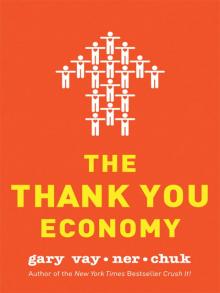 The Thank You Economy
The Thank You Economy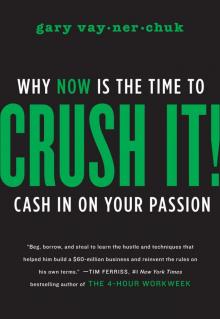 Crush It!
Crush It!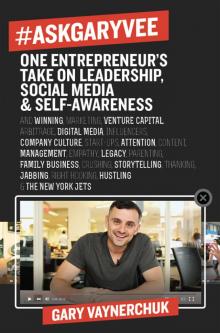 #AskGaryVee
#AskGaryVee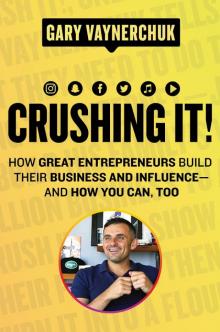 Crushing It! EPB
Crushing It! EPB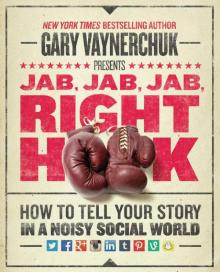 Jab, Jab, Jab, Right Hook
Jab, Jab, Jab, Right Hook